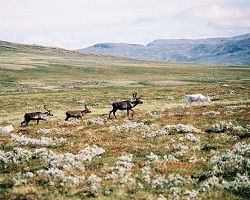show/hide words to know
Elevation: distance above or below sea level.
Permafrost: soil that remains frozen (below 0˚C/32˚F) for two or more years... more
Anatomy of the Tundra
Nature is never easy to understand, and the tundra proves it. Three types of tundra exist: antarctic, alpine, and arctic. The main difference between these types of tundra is their location on the earth. But they share many characteristics like cold, dry weather, which is why they’re all called Tundra.
Treeless Towers
Imagine a scene by the mountain with sly rodents, birds, and large mammals moving about the area. That’s what you’ll most likely see in the alpine tundra – “alpine” meaning mountains.

A small group of caribou, also known as reindeer, wander through the tundra. Image by M @ rkus.
This type of tundra is mostly in the northern hemisphere. It includes landscapes from mountain ranges into stretches of flat, cold desert. Only when you go farther south to the subalpine terrain will you reach the boundary where trees start growing (also known as the “timberline”).
In warmer weather of the alpine tundra, the situation improves and the landscape transforms into a sea of color where tundra-adapted plants and animals thrive. The alpine tundra doesn’t have permafrost, so soil can better absorb water. Because of that, alpine tundra is livable for plants and animals, like marmot, mountain goat, sheep, and upland ground birds. These animals and others migrate through this area over the course of the year. Seasonal climate changes make a world of difference to the tundra’s occupants.
Alpine Tundra on Mountain Tops
But don’t think the alpine tundra is only in far-off places. Around the world, alpine tundra can also be found on mountain tops. At very high elevations, mountain peaks can be consistently cold and dry with hardly any vegetation. Climate like that is similar to alpine tundra regions. These patches of tundra-like environments can be found on mountains in places like Norway and even Arizona.
It’s Getting Colder
Even though alpine tundra is always below zero at night, it’s not as cold as the Arctic. In the arctic or “polar” tundra, water from the ocean and pools on the ground freeze up, forming expanses of white ice over the ground. In the arctic, there is permafrost. The bare and rocky land supports low plant and animal diversity. Some groups of people live off the land by herding caribou.
Antarctica is the southern-most continent on the globe, and the edges of Antarctica are partly made up of antarctic tundra. Antarctica has many mountains and volcanoes, too. No people live there permanently, but scientists have set up research stations to study things like how organisms survive in extreme climates. It’s pretty inhospitable on the fields of ice, yet seals, birds, and many sea creatures survive there.
View Citation
Bibliographic details:
- Article: Anatomy of the Tundra
- Author(s): Melanie Sturm
- Publisher: Arizona State University School of Life Sciences Ask A Biologist
- Site name: ASU - Ask A Biologist
- Date published: February 17, 2014
- Date accessed: April 17, 2024
- Link: https://askabiologist.asu.edu/anatomy-tundra
APA Style
Melanie Sturm. (2014, February 17). Anatomy of the Tundra. ASU - Ask A Biologist. Retrieved April 17, 2024 from https://askabiologist.asu.edu/anatomy-tundra
Chicago Manual of Style
Melanie Sturm. "Anatomy of the Tundra". ASU - Ask A Biologist. 17 February, 2014. https://askabiologist.asu.edu/anatomy-tundra
Melanie Sturm. "Anatomy of the Tundra". ASU - Ask A Biologist. 17 Feb 2014. ASU - Ask A Biologist, Web. 17 Apr 2024. https://askabiologist.asu.edu/anatomy-tundra
MLA 2017 Style

The tundra covers a wide range of land types, from mountains, to slopes, to flats, as seen here in the Svalbard tundra of Norway.
Be Part of
Ask A Biologist
By volunteering, or simply sending us feedback on the site. Scientists, teachers, writers, illustrators, and translators are all important to the program. If you are interested in helping with the website we have a Volunteers page to get the process started.











